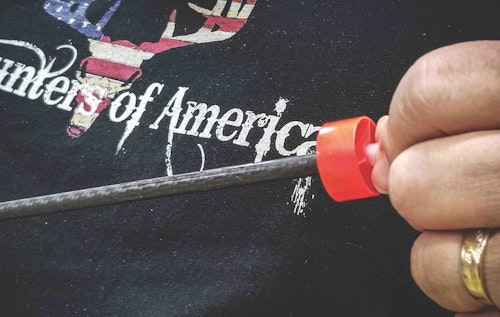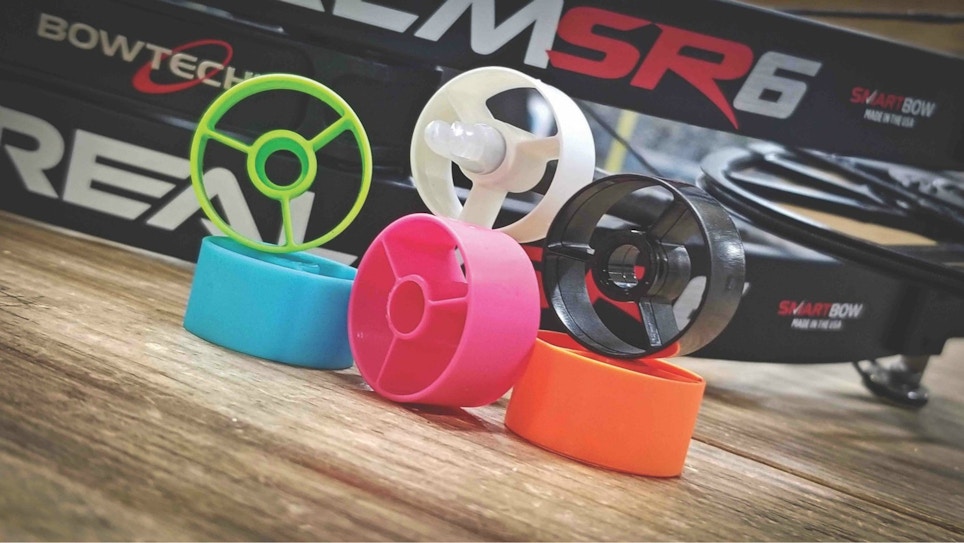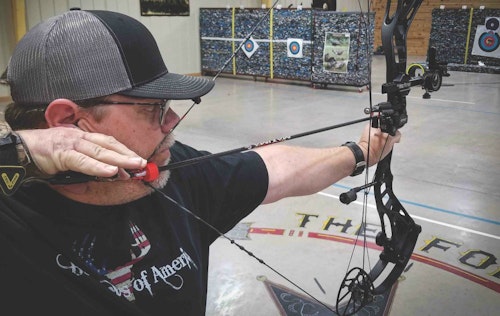Nearly 20 years ago, Paul Morris, a tried and true aerospace engineer — yes, a REAL rocket scientist — and avid bowhunter came up with the novel idea of producing an exceptionally aerodynamic “fletching” system with multi-faceted, rocket-sciency design and purpose. Did he succeed? That’s a subjective question for archers and bowhunters to answer for themselves, based on intended purposes. First, a little history …
From Starrflight to FOB
Morris’s FOB idea came to light in the early 2000s and with it, a truck load of subsequent research and development — I’ve met several rocket scientists and none of them fly by the seat of their pants. Risks, designs and developments, fuel cells or FOBs, are managed with painstaking, heavily calculated care. With respect to the FOB’s multi-purpose design, the level of effort invested into the finished product was quite staggering for a guy like me who doesn’t begin to understand the level of pre-wired scrutiny scientists exercise when it comes to their projects.
After years of research and development, the formation of Starrflight, and the addition of a partner, Larry Peterson, the duo unveiled the FOB in 2007 and the industry buzz was immediate. Just a couple years later, I was happily buying and cutting down bare arrow shafts and installing FOBs on my own arrows. Honestly, my first impression was based on arrow flight — it was superb.
In 2018, Luke Hardin, Brinck Bowers and Daniel Conner acquired Starrflight from Morris, rebranded it to FOB Archery, and hit the ground running like marketing madmen. Simply put, FOB Archery’s goal is to “develop and expand our product lines to provide bowhunters with a more successful and enjoyable experience.”

What is a FOB and Why Shoot It?
Put plainly, a FOB is a round, structurally rigid, 1-inch-diameter alternative to traditional fletching; thus, the name “Fletching Only Better.” As science applies to arrow flight with a FOB, the overwhelming benefit is airfoil technology with three internal “vanes.” As an airfoil, a correctly spined arrow recovers faster, spins tighter and demonstrates dramatically improved aerodynamics. A FOB even enhances overall arrow stability, especially over long distances, via circumferential lift, a side benefit to airfoil technology.
Even better, the profile of the FOB is only a half-inch. The reduced profile area of the FOB in comparison to feathers and vanes, even smaller 1.5- and 2-inch sizes, results in exponentially less wind-planing in tough shooting conditions. A FOB simply slides over the back of the arrow shaft and is held in place by the nock. FOB Archery offers FOBs in multiple colors and several different arrow shaft diameters to satisfy the lion’s share of archers and bowhunters. Each pack includes a clearance tool to ensure your arrow rest can accommodate the 1-inch-diameter FOB profile.
Additionally, when hunting, day or night, it’s important to note what happens when you achieve a pass-through shot. When an arrow passes through an animal, the FOB pops off to mark the area where the shot occurred. Finding the location of the shot is a great way to begin blood trailing.
Shooting: FOB’s Moment of Truth
With a recently dialed-in bow in hand, I grabbed two bare-shaft Maxima 350 arrows, installed FOBs, and prepared to shoot. Clearance and timing are the two most critical elements to consider when shooting FOBs. Structurally, FOBs are tough, thus reusable, but such an attribute doesn’t work well when traveling through confined space or with poor timing — FOB contact with an arrow rest wreaks havoc on flight. Before beginning, understanding how important timing is when shooting FOBs — collisions are incredibly violent — I prepared myself for the worst. I winced as I shot my first arrow; however, the rest fell in plenty of time. The second shot was much better and the arrow sunk into the 20-yard target close to center-mass. I made a couple bow sight adjustments and soon after was center-punching the target.
Once I settled in, I was concerned I would shoot one of the FOBs on one of the almost touching arrows and destroy it, so I began shooting five-spot targets at 20 yards, as well as a swinging 3-D ball target hanging from a rope just in front of the 20-yard target wall. I moved back to 40 yards and continued shooting exceptionally tight groups; in fact, tighter than I had shot for quite a long time.
Comparing a few old FOBs I still had in my tool box to the ones available today didn’t reveal anything mind-blowing. The FOBs are still FOBs. Aside from colors, they shoot precisely the same as they did before. My broadheads also impact precisely in the same spot as my field points. In testing, I shot Xecutioner Xpandables, Shuttle T-Locks and New Era Archery Zeus hybrid broadheads.
Because I’ve had the ability to field test older model FOBs as well as the newer ones, the good news is my latest results are the same as years ago — superb accuracy at any yardage within my routine shooting level. Due to that comparable old vs. new FOB performance, I can also confidently share hunting performance. In years past, I have taken scores of feral hogs using FOBs on both Carbon Express Maxima Hunters and Maxima Red 350s. The FOBs performed flawlessly. They never contacted my arrow rest and never flew off the arrow shaft prematurely. Honestly, for shooting paper and animals, I have never had a negative FOB experience.
Room for Improvement
What’s not to like about FOBs? Seriously, there isn’t much to dislike at all, but there are a couple issues worth noting. First, when using lighted nocks, FOBs fall off on a pass through shot, which is likely to alienate bowhunters like me who enjoy night hunting. It would be great to see FOB Archery offer compatible illuminated nocks to combat any sense of alienation. Second, when FOBs do fly off, they generally fly off just a few feet. This is a great indicator when beginning to look for first blood. Unfortunately, I have also seen FOBs fly off 10 to 20 feet on more than one occasion when achieving pass-through shots on feral hogs. This isn’t a deal breaker by any stretch, but if you think you don’t have to pay attention to where an animal was standing where you shot, sooner or later you’re going to be disappointed — at some point, that FOB will deflect from the body just enough to make finding first blood difficult. Finally, years ago, I read complaints about noise. Sure, you can hear FOBs during flight, but to me the noise is comparable to other vanes on the market.
Final Shots
Arrows with a FOB require a compound bow with a drop-away arrow rest, other designs simply won’t work. That being said, FOBs are certainly a home run with regard to arrow flight. FOB shooters can expect incredibly stable flight, even with precision-machined broadheads, over longer distances, with enhanced accuracy, from well-tuned bows. In addition to improved arrow flight, bare shafts are often less expensive than arrows with installed vanes. You can re-use FOBs, too. A pack of FOBs is likely to last years, and you don’t have to worry about repairing lost or torn vanes. While FOBs initially cost more than traditional vanes, the overwhelming savings over time should make any archer sit up and take note. FOBs give a lot of bang for your hard-earned bucks.
To learn more about FOB Archery, visit www.fobarchery.com.







